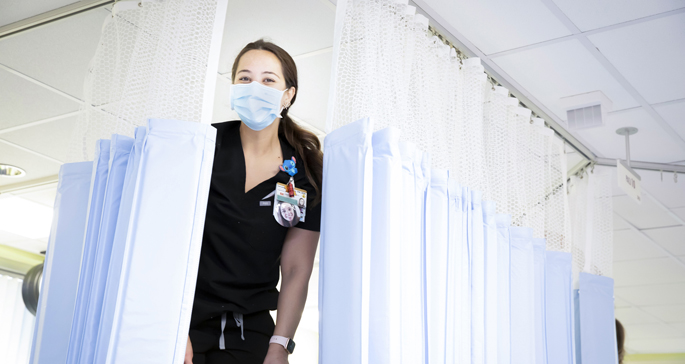
At Monroe Carell Jr. Children’s Hospital at Vanderbilt, the post-anesthesia care unit, or PACU, is a hive of activity as patients are awakened from their operating room procedures. Given that each patient’s awakening is meant to be gentle, the general noise level in the PACU prompted concern from staff nurse Savannah Ramsey, RN.
“A survey of the literature indicates not only that higher noise levels contribute to medical errors, but that PACU patients require more analgesia when noise levels are higher,” Ramsey said. “Noise also tends to raise stress levels — not optimal for patients, nor, for that matter, for health care workers. I thought there might be an opportunity to bring down the sound level without disrupting unit operations.”
With the help of a small group of colleagues and some strategically placed sound-level measuring devices (noise dosimeters), Ramsey studied the effectiveness of a set of measures intended to quiet down the PACU. Interventions included installation of noise dampening curtains around selected patient bays; nurse education concerning the appropriate adjustment of alarm parameters for each new patient; lowering the volume of certain audible automated team reminders; and a visual cue — a traffic-signal-type display triggered by a built-in noise-level meter — when staff conversations got too loud.
“Based on weeks of sound-level measurement pre- and post-intervention, the resulting reduction in noise levels was quantifiable and statistically significant,” Ramsey said, “and large enough to warrant leadership approval to roll these interventions out throughout the PACU.
“I would definitely recommend these noise-quelling interventions to other patient care areas that might have similar issues with noisiness.”
The study was published in a recent issue of The Empowered Nurse (employee login-in required), an in-house peer-reviewed journal devoted to VUMC nursing research. Joining Ramsey in the study were Elizabeth Card, MSN, RN, APRN, FNP-BC, Summer Fitts, RN, CPAN, and Leighann Chadwell, MSN, RN, NE-BC.
Earlier nursing research in the operating room at Vanderbilt University Adult Hospital, presented in 2019, demonstrated that noise negatively affects individuals and patient safety.
In 2019, Card and Glendyle Levinskas, RN, CNOR, presented “Operating room (OR) noise is a health and safety risk: A real time measurement of noise level during critical times of surgery and multidisciplinary staff’s noise perception in Vanderbilt adult OR” at the Association of periOperative Registered Nurses National Conference.
The purpose of the study was to investigate the effects of noise and noise reduction strategies on individual and patient safety and to assess OR noise levels during critical times. It found that the OR operating room is one of the noisiest clinical areas due to information sharing among the clinical team, various technology devices and surgical equipment.
In addition to Levinskas and Card, other participants in the research in the adult hospital were Cynthia Kildgore, MSHA, RN, CNOR; Oscar Guillamondegui, MD; Steve Hyman, MD; Matthew Fosnot, MSN, APRN, CRNA; Buffy Krauser Lupear, DNP, APRN, CRNA; and Diane Johnson, MSN, RN.












